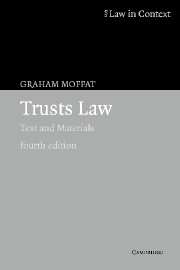Book contents
- Frontmatter
- Contents
- Preface
- Acknowledgments
- Table of abbreviations
- Useful websites
- Table of statutes
- Table of statutory instruments
- Table of cases
- 1 Trusts introduced
- 2 The evolution of the private express trust
- 3 Taxation, wealth-holding and the private trust
- 4 Creating the Trust – I
- 5 Creating the Trust – II
- 6 Trusts and public policy
- 7 Flexibility in relation to beneficial entitlement
- 8 The taxation of private trusts
- 9 An introduction to trustees and trusteeship
- 10 Aspects of the management of trusts
- 11 Trusteeship, control and breach of trust
- 12 Imputed trusts and family breakdown
- 13 Trusts in commerce I: occupational pension schemes
- 14 Trusts in commerce II: commerce and equitable remedies
- 15 Trusts in commerce III: commerce, credit and the trust
- 16 Trusts in commerce IV: fiduciary relationships, commerce and the trust
- 17 Trust, contract and unincorporated associations
- 18 An introduction to the law of charity
- 19 A legal definition of ‘charity’
- 20 The regulation of charities
- Index
9 - An introduction to trustees and trusteeship
- Frontmatter
- Contents
- Preface
- Acknowledgments
- Table of abbreviations
- Useful websites
- Table of statutes
- Table of statutory instruments
- Table of cases
- 1 Trusts introduced
- 2 The evolution of the private express trust
- 3 Taxation, wealth-holding and the private trust
- 4 Creating the Trust – I
- 5 Creating the Trust – II
- 6 Trusts and public policy
- 7 Flexibility in relation to beneficial entitlement
- 8 The taxation of private trusts
- 9 An introduction to trustees and trusteeship
- 10 Aspects of the management of trusts
- 11 Trusteeship, control and breach of trust
- 12 Imputed trusts and family breakdown
- 13 Trusts in commerce I: occupational pension schemes
- 14 Trusts in commerce II: commerce and equitable remedies
- 15 Trusts in commerce III: commerce, credit and the trust
- 16 Trusts in commerce IV: fiduciary relationships, commerce and the trust
- 17 Trust, contract and unincorporated associations
- 18 An introduction to the law of charity
- 19 A legal definition of ‘charity’
- 20 The regulation of charities
- Index
Summary
Introduction
One of the first decisions to be taken by a settlor or testator creating a trust concerns the selection of the trustees. Who should be appointed: the settlor himself or herself, a family friend, a professional person – probably an accountant or solicitor – or a corporate trustee such as a trust department or trust subsidiary of a bank, or indeed some combination of these? The decision is of the greatest importance. Not only may the trustees be empowered to decide beneficial entitlement but also they will be responsible for trust administration including preserving the value of the trust fund through effective investment. Decisions about whom to appoint assume the existence of people or organisations willing to serve as trustees. After all, people cannot be forced to become trustees of express trusts, and if appointed may immediately disclaim or subsequently retire (see Chapter 11). It may therefore be important that the law, in seeking to oversee the exercise of trusteeship, does not unduly discourage potential trustees.
This chapter and the next two are concerned predominantly with the benefits and burdens of trusteeship. First, this chapter focuses on the nature of trusteeship with particular reference to a possible source of tension created between, on the one hand, a concept of trusteeship rooted in moral obligation and, on the other, one which perceives trusteeship as a managerial function to be financially rewarded.
- Type
- Chapter
- Information
- Trusts LawText and Materials, pp. 404 - 441Publisher: Cambridge University PressPrint publication year: 2005

